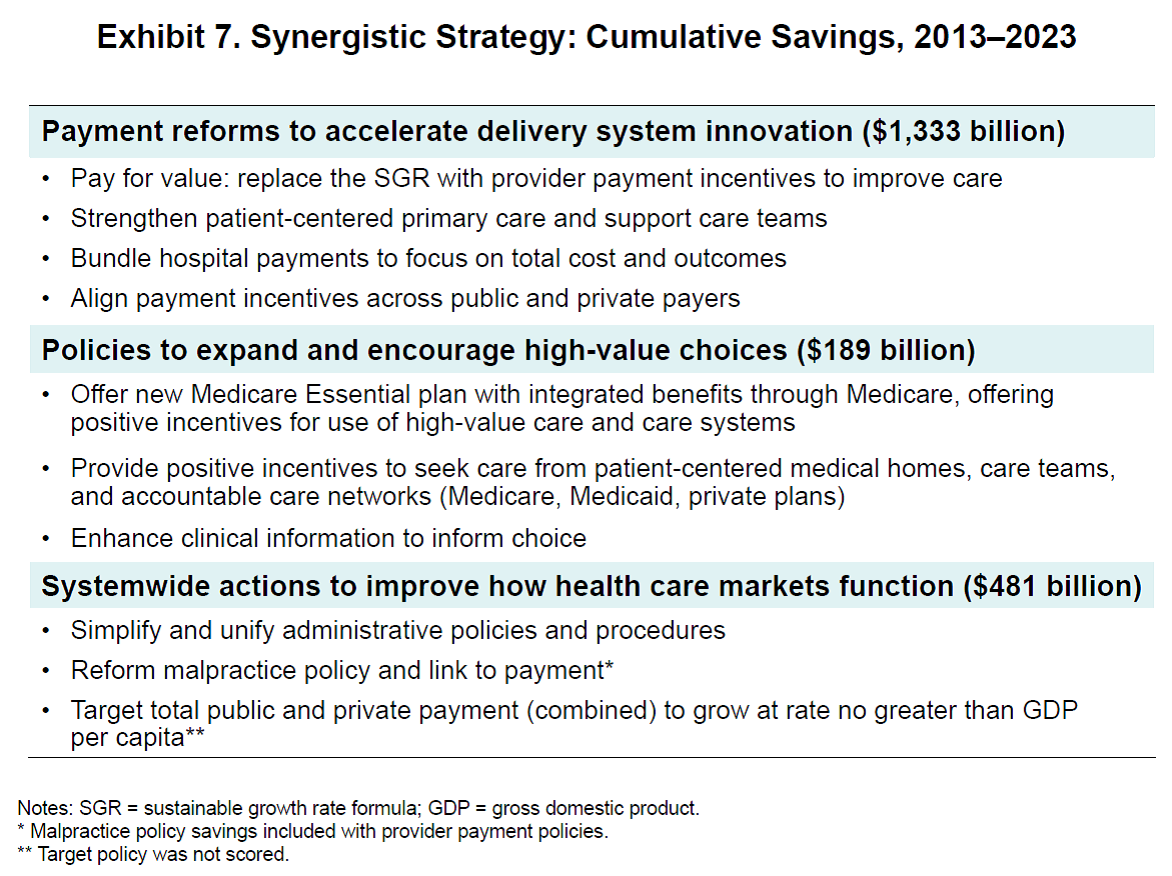The Commonwealth Fund's Plan to Tackle Health Spending
Earlier this week, we discussed the recent slowdown of National Health Expenditures (NHE) and how, while promising, it may not last. That means more must be done to control health care spending in the future. Today, the Commonwealth Fund's Commission on a High Performance Health System released a report addressing this very issue and proposing a plan to reduce overall NHE by $2 trillion through 2023.
Their plan includes a number of integrated policies to reduce health spending with the goals of promoting value and accelerating health care delivery system innovation in payment reform; expanding options and encouraging high-value choices by consumers with better information about the quality and cost of care; and enacting system-wide improvements to how health care markets function, such as reducing administrative costs and setting national and regional targets for spending growth. These policies include:

In their analysis, the authors use the National Health Expenditure Accounts from the Centers for Medicare and Medicaid Services Office of the Actuary to develop their own baseline to estimate savings not only to the federal government, but to state and local governments, private payers, and households as well. Of the $2 trillion they estimate their plan achieves, the federal government would save roughly $1 trillion over the next decade. While the impact may be uncertain, many of these policies would achieve savings that could be measured by the Congressional Budget Office. The technical analysis provided along with the report offers a useful exercise in gauging what impact these policies could have using other measures of scoring.
The Commonwealth Fund study also underscores the need for federal reforms to help drive innovation in the private market that will help to lower overall health care spending. This includes encouraging care coordination for high-cost beneficiaries, rewarding use of patient-centered medical homes and high-value providers, driving payment reform, and improving administrative standardization.
One of the key components to their plan is the design of a new "Medicare Essential" benefits plan. This would be a new comprehensive insurance plan for Medicare beneficiaries to choose from that reduces the need for supplemental coverage to pay for various out of pocket costs (i.e. Medigap or other insurance plans). This option would integrate Medicare Part A, B, and D with a single deductible and an out-of-pocket maximum, cover preventive care in full, and vary copayments and coinsurance with incentives to seek high-value providers and systems. It is designed to be budget neutral and would take in premiums to offset the cost of a richer benefit package.
Another overarching policy to the Commonwealth Fund plan is setting a health care spending target. The plan would target total health care spending to grow at a rate no greater than GDP per capita. This option effectively creates a global budget for health care which would be implemented federally, but also encourage state, local, and private payers with various incentives to ensure spending targets are met. The report leaves out what these incentives could be and how various payers would implement spending reductions, but it would have the potential to yield the significant savings in the long term if designed well. The authors estimate about $483 billion in savings would go to the federal government.
Overall, the Commonwealth Fund’s plan adds to the national discussion about how to reform federal and total health care spending as we confront uncertain health care cost growth and an aging population. Several of their policies overlap with ideas we’ve highlighted before in previous reports. As the conversation in Washington shifts to looking at ways to reform federal health spending, all of these options should remain on the table.
Click here to read the full report.


